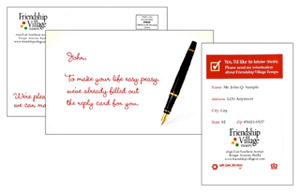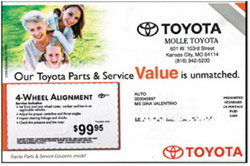Many multichannel merchants have cut back on or even eliminated the mail channel in recent years because of the high costs associated with print. That’s not to say print is dead: Catalog marketers are still mailing books, but they’re also looking at noncatalog forms of print.
Multichannel Merchant’s Outlook 2011 research found that 50% of respondents had used postcards in the past 12 months, 40% mailed fliers, 28% tried solo mailers and 38% used direct mail. What’s more, nearly half (48.2%) of respondents to the Outlook 2011 survey said they were planning to use direct mail in the next 12 months.
Why the interest in direct mail? For many marketers, carefully targeted direct mail remains the most cost-effective way to reach and get profitable orders from some audience segments.
When used wisely and analyzed carefully, direct mail outperforms many tactics, particularly with prospects and also with many customer segments. Like catalogs, direct mail pieces are tactile, targeted and measurable; they can also be easily personalized and integrated with the rest of your contact strategy.
You don’t have to be a large mailer to enjoy the benefits of carefully targeted direct mail. One locally focused company I know of reports continued sales growth as a result of direct mail — and we’re talking mailings of less than a few thousand pieces.
A financial services firm saw a tripled response rate within two months from testing 10,000 direct mail pieces across zip codes. When I asked a contact at the company how it managed this, the answer was “overwhelming success targeting the right prospects.”
So you might want to look at direct mail as one element in your multichannel strategy. Today’s sophisticated capabilities let you analyze and model customer files and prospect databases and zero in on those segments for which direct mail pays off. You can also better determine the most cost-effective number of efforts and timing.
Moreover, it’s not unusual for a mailer to see double-digit response rates from direct mail — it all depends on the audience, timing, creative and offer. The message — the compelling reason for the recipient to take action — is critical to a direct mail piece’s success.
Here are some creative pointers for marketers starting, reactivating or improving a direct mail program.
Leveraging postcard formats

Depending on your product line and target market, it may be worth exploring and testing postcard formats because of their inherently low costs.
The First Class commercial postcard costs $0.29 to mail, and delivery takes one to five days. You can further reduce costs by presorting for First Class or mailing at the Standard service rates, which range from $0.24 to $0.27 per piece. (Nonprofits have an entirely different pricing structure.)
Per the U.S. Postal Service, a postcard must be rectangular, at least 3.5″ high, 5″ long and 0.007″ thick, and no more than 4.25″ high, 6″ long and 0.016″ thick.
Your specific goal will determine the direct mail format that’s most likely to be effective. A few examples:
- To encourage prospects to request more information, test a double postcard with a postage-paid reply card.
- To direct mail recipients to call to speak with a representative, a postcard, gatefold piece or letter in an envelope all generally work well.
- To drive a purchase with the piece, consider testing a postcard with scratch-off, an oversize postcard, or a letter in an envelope. You might even enclose a sample, if feasible and not cost-prohibitive.
Remember that with postcards, the critical key is sticking with a single message and single call to action.

Getting personalization down
Generally, the more personalized the mail piece, the higher the response rate. Personalization and prepopulating information increase response by 12% to 35%. Today’s variable inkjet imaging (which often includes high-resolution artwork and logos) is inexpensive and can make your piece highly targeted.
The example on page 24 shows how retirement community Friendship Village uses a postage-paid business reply card with a prefilled form on the opposite side. This type of campaign is hurdle-free for the recipient — just tear off the perforated the card and drop it in the mail.
Brainstorm about how you can personalize most effectively within your direct mail formats, given your product categories and audience. Are there ways you can use data about a customer’s preferences or past purchases to make a relevant reference or offer?
Personalization within formats that allow for coupons or gift cards can also work well. The Office Depot piece shown above uses variable inkjet information in two locations, plus a coupon for the recipient and a coupon for a friend. This is a cost-effective way to personalize the information because the creative itself does not change; only the information that is inkjet-imaged changes.
Explore all possibilities

When you can sufficiently target/qualify recipients, and the products or services are high-ticket, or lend themselves to ongoing/repeat purchases and high lifetime value, direct mail formats often prove well worth the upfront investment.
An example of this is the sophisticated mailing pieces that auto dealerships employ to sell car buyers on coming back to them for scheduled maintenance. (See Toyota example below.)
Another example: The Postal Service, practicing what it preaches to its direct mail customers, sent out a piece offering $80 worth of savings, plus an informational CD tucked on the inside.
Remember that only testing can determine which formats will appeal to and drive sales from segments of your audience. It’s also smart to seek advice from your service providers (printer, mailer, data processor) about which formats and variable information/personalization elements are most likely to work for your company.
But full-blown, multicomponent direct mail pieces can still pull profitable business, if you use them to direct strong offers to the right segment at the right time.
Gina Valentino ([email protected]) is president of Hemisphere Marketing, a Kansas City-based catalog creative and marketing services agency.